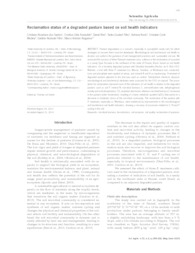Reclamation status of a degraded pasture based on soil health indicators.
Reclamation status of a degraded pasture based on soil health indicators.
Autoria: SANTOS. C. A. dos; KRAWULSKI, C. C.; BINI, D.; GOULART FILHO, T.; KNOB, A.; MEDINA, C. C.; ANDRADE FILHO, G.; NOGUEIRA, M. A.
Resumo: Pasture degradation is a concern, especially in susceptible sandy soils for which strategies to recover them must be developed. Microbiological and biochemical soil health indicators are useful in the guindace of soil management practices and sustainable soil use. We assessed the success of three Panicum maximum Jacq. cultivars in the reclamation of a pasture in a sandy Typic Acrudox in the northwest of the state of Paraná, Brazil, based on soil health indicators. On a formerly degraded pasture with Urochloa brizantha (Hochst. ex A. Rich.) R.D. Webster, a trial with three P. maximum (cv. Massai, Tanzânia, or Mombaça) was conducted. Lime and phosphate were applied at set-up, and mineral N and K as topdressing. A remnant of degraded pasture adjacent to the trial was used as control. Twenty-three chemical, physical, microbiological and biochemical attributes were assessed for the 0-10 cm topsoil. The procedures for reclamation improved most of the indicators of soil health in relation to the degraded pasture, such as soil P, mineral N, microbial biomass C, ammonification rate, dehydrogenase activity and acid phosphatase. CO2 evolution decreased, whereas microbial biomass C increased in the pasture under reclamation, resulting in a lower metabolic quotient (qCO2) that points to a decrease in metabolic stress of the microbial community. The reclamation of the pasture with P. maximum, especially cv. Mombaça, were evidenced by improvements in the microbiological and biochemical soil health indicators, showing a recovery of processes related to C, N and P cycling in the soil.
Ano de publicação: 2015
Tipo de publicação: Artigo de periódico
Unidade: Embrapa Soja
Observações
1 - Por padrão são exibidas publicações dos últimos 20 anos. Para encontrar publicações mais antigas, configure o filtro ano de publicação, colocando o ano a partir do qual você deseja encontrar publicações. O filtro está na coluna da esquerda na busca acima.
2 - Para ler algumas publicações da Embrapa (apenas as que estão em formato ePub), é necessário ter, no celular ou computador, um desses softwares gratuitos. Sistemas Android: Google Play Livros; IOS: iBooks; Windows e Linux: software Calibre.
Acesse outras publicações
Acesse a Base de Dados da Pesquisa Agropecuária (BDPA) para consultar o acervo completo das bibliotecas da Embrapa.

